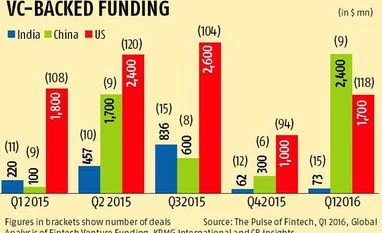Gupta isn't the only one who has been in what has been a segment globally considered hot. According to a report released by KPMG and CBinsights, VC investments in the first quarter of calendar year 2016 (CY16) crossed $4.9 billion globally across 218 deals.
VC-backed deal activity rose 22 per cent in the first three months of CY16 on a quarterly basis, while overall fintech deals rose 39 per cent from the fourth quarter of CY15, stated the report.
"Fintech had a very strong start to the year, and with the recent multi-billion dollar investment in Ant Financial in April, we are starting to see fintech move into the mega-deal space," said Warren Mead, global co-leader of fintech, KPMG International and Partner, KPMG in the UK in the report.
China, meanwhile, saw nine deals with investments worth $2.4 billion in the latest quarter compared to $0.3 billion in the fourth quarter of CY15. Lu.com's capital influx worth $1.2 billion has made it the biggest investment of the year so far.
In India, however, there has been a general sense of malaise when it comes to fintech.
In the fourth quarter of CY15, the report said, the country saw only 12 deals worth $62 million. While the number of deals did rise in CY16, the cheque size was only $73 million.
"India is not as mature as the US or China markets. But if you see, apart from Paytm and MobiKwik, most investments were made on the seed stage and that's where we are. Companies have just started to grow in the Indian market," said Gupta. He, however, admitted the rate of investments was slower than that of other start-up sectors. But he chose to put a positive spin on it. "I prefer it this way. It is better than sharp exuberance and then a sudden deflation."
Power2SME, an online marketplace catering to small and medium enterprises (SMEs), had one of the big deals with the company raising $20 million in Series C round.
In January, Nandan Nilekani made a strategic investment in the company. "Power2SME has a unique business model that focuses on making SMEs bankable and profitable and am excited to watch the growth journey of this company as it continues to contribute in strengthening the SME social fabric of the nation," he had said.
While there was the enthusiasm, it didn't, however, explain why there was a drop from the third quarter of CY15, where $836 million was invested in 15 deals. The answer is simple. Paytm drew a lot of investment funding last year and that might have inflated the numbers. MobiKwik, which raised Rs 44 crore in debt and equity from Sequoia Capital and Tree Line Asia too pads the books.
"Also, there were a spate of P2P (peer-to-peer) lending platforms that mushroomed in China and then they disappeared without a trace. It played a role in why investors became more cautious," Gupta said.
Harish H V, partner at Grant Thornton, explained that one of the reasons why the enthusiasm has been dampened is Reserve Bank of India regulations. "The regulations are needed because you are dealing with someone's money and you have to be careful with it."
Harish said that banks, too, had become more proactive and were cornering the fintech market, which meant VCs didn't see the point of making big bets. He also explained that the one reason why the big money hasn't been coming in is the absence of a breakthrough product. "Perhaps, the big money investment will flow when the next big innovation hits the market."
)